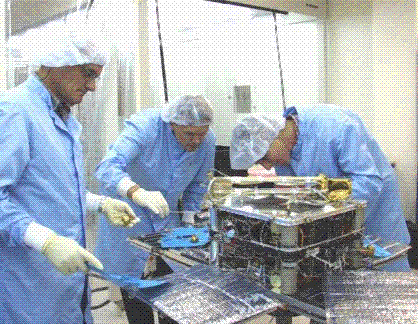
Tim Furniss/LONDON
On 10 December, while the first components of the International Space Station were catching the world's eye, Sweden launched its Astrid 2 science satellite. The launch was made aboard a Russian Cosmos 3M booster from the Plesetsk Cosmodrome as part of a contract with the Russian Polyot organisation. The 30kg (66lb) satellite was riding piggyback with a Nadezhda spacecraft.
Small fry it may seem, but the development of Astrid 2 is another illustration of a successful, self-contained national space programme that began in 1979. The Swedish Government was keen to enable its industries to be more competitive, particularly in the international communications market.
The country had already been making some smart moves. Before the space programme had begun, it had joined the fledgling European Space Agency (ESA), with an investment of about 2%, a proportion it still maintains, out of a total national space budget of about Skr550 million ($68 million).
Sweden's Esrange sounding rocket launch centre in Kiruna conducted its first launches in 1966 and over 400 have since taken place for international users. Sweden joined Germany's Texus sounding rocket programme in 1977 and, in 1987, led the development of a larger Maxus rocket, based on the USA's Thiokol Castor IV booster. This enables science and processing experiments to experience up 14s of microgravity during suborbital flights.
Kiruna is also the site of the control centre for Sweden's telecommunications satellites and is a processing and marketing centre for remote sensing satellites as part of the Swedish Space Corporation's (SSC) Satellitbild organisation. SCC, based in Solna near Stockholm, has been at the centre of the national space programme, basically running it as a government-owned limited company responsible to the Ministry of Industry and Trade. SCC is also a part owner of Nordic Satellite, a company that operates the Sirius communications satellite system. This consists of the Sirius 2 spacecraft, built by Aerospatiale, and Sirius 1, a Hughes-built(former British Satellite Broadcasting Marcopolo 1) satellite purchased in 1993.
A forerunner to Sweden's communications satellite system was the Tele-X Scandinavian direct broadcasting satellite, built largely by Germany, based on its TV-Sat spacecraft bus, and launched in 1989. Sweden's indigenous satellites have been directed to a national forte, science, linked initially to a prevalent natural phenomena, the Aurora Borealis.
VIKING EXPERIMENTS
The Saab 286kg Viking 1 satellite was launched by an Ariane in 1986, carrying experiments to investigate the interaction of the solar wind with the earth's magnetosphere.
Viking's successor, the 214kg Freja, continued investigations of this upper atmosphere auroral zone after launch in 1992 as a piggyback payload on a Chinese Long March 2C booster. The Freja spacecraft bus was scaled down as the Freja C, to form the platform for a series of lower-cost, smaller science satellites, which kicked off with Astrid 1.
Astrid 1, launched on a Cosmos booster in 1995, was largely an SSC-built technology demonstrator for the small satellite bus, but it monitored the magnetosphere successfully, making ultraviolet images of the aurorae. Astrid 2, now safely in an 83° inclination, 1,000km circular orbit, is based on this minisatellite bus. It is equipped with auroral imagers and electron and ion detectors.
The payload was developed by the Swedish Institute of Space Physics. An Astrid 3 is under consideration.
The SSC, with the Swedish National Space Board, is developing Odin, a larger, 235kgsatellite to be launched on a Russian Startbooster. Odin will be used for a joint astronomy and aeronomy mission with France, Canada and Finland, studying the balance of ozone and greenhouse gases in the upper atmosphere from its 600km, sun-synchronous orbit.
The SSC is prime contractor for a new ESA project, the first in a series of Small Missions for Advanced Research in Technology (SMART) spacecraft. SMART 1 is to be Europe's equivalent of NASA's New Millennium Deep Space spacecraft, technology demonstrators for new deep space missions.
SMART 1 will fly a xenon ion-propelled moon mission that might pave the way for a trip to Mercury. SMART 1 will enter a geostationary transfer orbit after its piggyback launch on a commercial Ariane 5 mission in about 2000-1, and will fire its ion engine to increase its orbit gradually over 200 days so that its flightpath will come close to the moon.
The spacecraft will also use charge coupled device imagers for star tracking, as a demonstration of how future spacecraft may be able to recognise any star pattern without intervention for the ground. Normally, star tracking involves a spacecraft sending data to earth for instant computer comparison with star charts.
Source: Flight International























